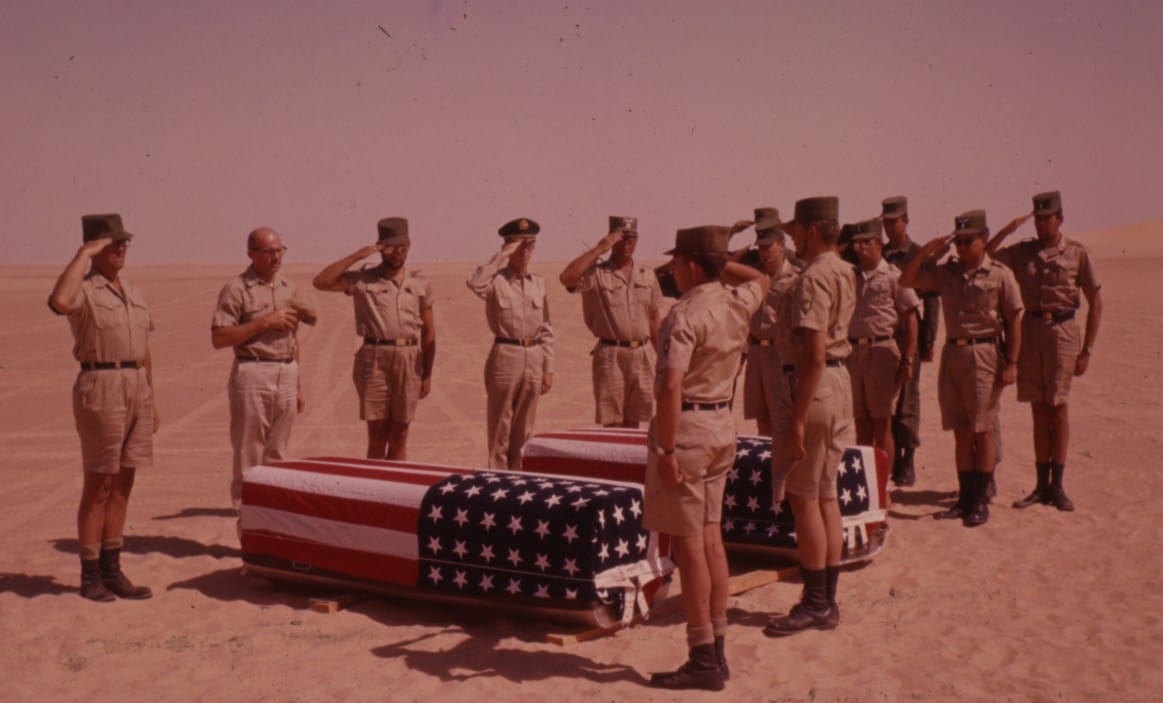Gradually Giving Up Her Secrets
Her machine guns were still functional. So too was her radio. The remarkably well preserved fuselage still contained supplies of food and water. Liquid tea found in the wreck was still drinkable. One engine was found to be operational. But there were no human remains in or around the Lady and she contained no parachutes. In February of 1960, the United States Army sent a search team to determine the crew’s fate. The remains of Bill Hatton, Bob Toner, D.P. Hays, Bob LaMotte and Sam Adams were found in close proximity to each other on 11 February 1960. Subsequent Air Force searches (collectively dubbed Operation Climax) eventually found the remains of Guy Shelley and Harold Ripslinger. John Woravka’s remains were found by another BP oil exploration crew a few months later. The remains of Vernon Moore were never found.

Dear Diary Tells the Tale
Unraveling the mystery of the Lady Be Good and her crew’s fate began with finding their bodies but continued with a diary found in Bob Toner’s pocket. The diary recorded the crew’s actions. It was discovered that John Woravka and died separately from the others as a result of a malfunctioning parachute. After remaining eight crew members located each other on the desert floor, they began walking north in an attempt to reach the Libyan coast they believed was much closer than it actually was.

Desperate in the Desert
Toner’s diary indicated that none of the men knew the Lady was flying over land when they abandoned her or that they were approximately 400 miles away from the coast. The crew left a trail of personal equipment shaped in arrows indicating their path behind them as they walked. The crew had one canteen of water to share between them for eight days. The remains of the five crew members found close together indicated that the crew had split up, with three of the crew continuing north to find help. Help they never did find. Those three crew members were found individually having continued northward until each of them succumbed to thirst, fatigue, and hopelessness.

What Might Have Been
It is at least possible the crew could have survived their ordeal had they known where they were. Had the crew walked south instead of north an oasis (Wadi Zighen) was within walking distance. Had they found the relatively intact wreckage of the Lady, they might have been able to use her still-operational radio to call for help. After the Lady was identified and analyzed parts of her were distributed to museums and town halls over many years. In 1994 the remaining hulk of the Lady Be Good, mysterious no more, was moved to a Libyan military base where it remains today.

Twists of Fate Years Later
The story has a strange postscript. Some of the parts recovered from the wreck of the Lady were used in other aircraft. The story goes that an American Douglas C-54 that received propeller control parts from the wreck of the Lady experienced propeller problems bad enough to force the transport to jettison cargo in order to land safely. A Douglas C-47 Dakota that received a radio receiver from the Lady was forced to ditch in the Mediterranean. And the strangest one of all is the United States Army deHavilland DHC-3 Otter single engine transport that received an armrest that once belonged to the Lady Be Good. The Otter subsequently crashed into the Gulf of Sidra off the Libyan coast while carrying ten men. No trace of the men was found. One of the few pieces of the destroyed Otter to wash up on the Libyan coast was…that same Lady Be Good armrest!
[youtube id=”d9W5P3-mxwY” width=”800″ height=”454″ position=”left”]

A couple of corrections: the Lady be good DID join the formation and was the lead bomber when the last four turned back (aborted). The recovery did arrive on May 26, 1959, but the oil team had already visited her on February 27, 1959 and they notified the air force of the finding. It was COFFEE not tea that was found in the thermos. It was the oil team that found seven of the eight bodies. The Air Force only found Ripslinger’s body. It was only two of the three bodies that separated were found. Moore’s body has never been found. The arm rest that was found was only a copy of the arm rest from the Lady.